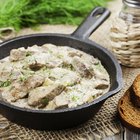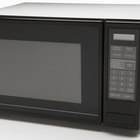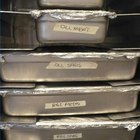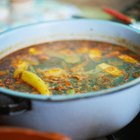
On those days when you don't feel like cooking, ordering takeout is an appealing option. It saves the time you'd spend on cooking and it also reduces the cleanup time after. If you order enough -- a big spread of Chinese food, for example -- you'll even have leftovers to pick at all evening, or you can pack them for the next day's lunch. Just remember, there's a limit to how long the food can sit out of the refrigerator.
Into the Danger Zone
The problem with leaving your food at room temperature is that it's squarely in the middle of the food safety "danger zone." That's the range of temperatures, between 40 and 140 degrees Fahrenheit, where potentially dangerous bacteria reproduce most rapidly. This is important -- because in most cases, it takes a relatively large number of bacteria to make a healthy person sick. Cooking kills most of the bacteria in food, so it's the time spent at room temperature after cooking that lets bacteria get re-established.
Drawing the Line
The USDA's Food Safety and Inspection Service considers two hours to be the longest amount of time that any food should be permitted to sit out without refrigeration. If your leftover dim sum spends longer than that at room temperature, it gives bacteria an unnecessarily good opportunity to reproduce. The clock starts running when the food dips below a temperature of 140 F, which is usually while it's on the way to your house. If the food isn't piping hot when it arrives, you might not even have a full two hours to work with.
Cranking the Heat
If your food isn't hot when it arrives, you can reset the virtual food-safety clock by reheating the food in your oven, microwave or individual saucepans. Treat the food as you would treat leftovers or any other previously cooked food, by bringing it up to the USDA's recommended food-safe temperature of 165 F for reheated food. If you're using your microwave, which heats unevenly, stir the food regularly and test it in several places with an instant-read thermometer just to be sure. Once the food is up to temperature, it's safe to eat, and your two-hour time limit starts over.
Packing It Away
When you've eaten your fill of Chinese food, any leftovers should be packaged and chilled within the same two-hour limit. Pack up the food either dish-by-dish or in individual "combo" meals, whichever you prefer. It's best to keep the portions small and the containers flat, so your food will cool quickly in the fridge or freezer. Don't stack the containers if you can help it, because that traps heat and slows the cooling process. If you have to stack them to make the fit in your fridge, rotate the containers so they can cool evenly. Eat refrigerated leftovers within three to four days, or freeze them for three to four months.
Related Articles

How Long Is Leftover Spaghetti Good to ...
What Are the Dangers of Cooked Meat ...

Number of Times Food Can Be Reheated

Proper Ways to Cool Food After Cooking

Can You Cook Frozen Foods That Are Past ...

How Long Can Cooked Salmon Last ...

How to Reheat Chinese Takeaway

Can You Let Crock-Pot Meals Sit?

Cooking Frozen Vs. Defrosted Food

How to Cook With Saran Wrap

Can You Cook Something Frozen in the ...
Can You Cook Chicken Wings the Day ...

Catering Tips for Delivering Food

How to Use a Probe Cooking Thermometer

How to Store Dehydrated Foods
How to Keep Deli Meats & Fruit Cold at ...

Containers That Keep Food Hot

Guidelines For Refreezing
How Long Can Leftovers Be Refrigerated?

How Long Can a Bagel With Cream Cheese ...
References
Writer Bio
Fred Decker is a trained chef and prolific freelance writer. In previous careers, he sold insurance and mutual funds, and was a longtime retailer. He was educated at Memorial University of Newfoundland and the Northern Alberta Institute of Technology. His articles have appeared on numerous home and garden sites including GoneOutdoors, TheNest and eHow.
Photo Credits
Spike Mafford/Photodisc/Getty Images